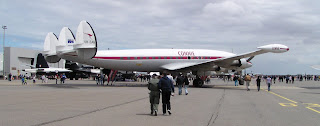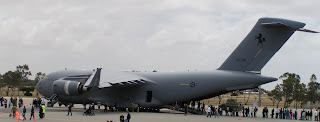Pigs, Cats and 'Bous
Yesterday Jo and the boys took me to the airshow at RAAF Edinburgh. It was a joint effort by the three military arms to promote themselves, but it was all about aeroplanes, and we know which one of them has aeroplanes, eh?
As we walked through the car park the Roulettes aerobatic team was in full Pratt-and-Whitney turbo-prop howl, which got the boys' attention.

They were a bit fast for my digital, which only now and then decided to take a photo on the same day as the air show. But here is part of them on the ground. The guys in the suits are ground crew so there is still a chance that at least one of the pilots has a moustache, despite EJ speculating that they did not.
The weather was hot, blustery and dusty for day one of the show. We got there around midday on day two, when it was cold, blustery and occasionally drizzling.

Joanne's sinuses were not comfy. In the distance are some of the residential Orions of 10 and 11 Squadrons, and half in the picture is an old Meteor jet fighter of the Temora Aviation Museum whose Canberra jet bomber was nearby.
The most striking aircraft as we went in was the Historic Aircraft Restoration Society's restored Lockheed Constellation airliner. The airframe was recovered from an aircraft graveyard in the U.S.A. and restored to flying condition.

We were able to go on board, and "Connie" was just as impressive inside. It was the Jumbo or Airbus 380 of its time, a luxurious giant, as passenger aircraft went, able to fly above the weather, to the greater comfort of passengers. A little of the type's origin is mentioned in the Leo Dicaprio movie, "The Aviator", Howard Hughes having driven its development.

See, lots of room!
Apart from sheltering in occasional aircraft, we also managed respite from the wind in a hangar to consume our lunchtime hot-dogs (some of us paying great attention to detail of the task, EJ!) where we also grabbed a handful of posters and pamphlets.
The show served to display the RAAF's new transport aircraft, the C-17 Globemaster.

The lineup to get a look inside went from here to next Saturday so we didn't bother! Meanwhile, plenty was happening overhead. Mostly flocks of seagulls, near the food end of the apron. Even they have defence applications - my digital kept focussing on them whenever I wanted to photograph a fly-past so I would suggest our service aircraft carry twenty or so to drop if any missiles lock onto them.

I did manage to finally see the legendary "dump-and-burn" which is a hallmark of the RAAF's F-111 "Pigs" at air shows. You won't see this anywhere else. Apart from the US, Australia was the only other user of the F-111, and the Americans have retired theirs.
The US referred to their F-111s as "Aardvarks" because of the low-slung look of the nose and its low-level abilities, as if it was snuffling around in the dirt. The Aussies called it a "Pig" for the same reasons. A very fast pig, though.
If we didn't get inside the C-17, the boys and Jo at least got a little more shelter from the wind by slipping inside the Caribou, a Canadian designed transport capable of getting in and out of limited landing fields.

The RAAF has been trying to replace them for a very long time. There doesn't seem to be anything which can do the same job.
While they were in there, the FA-18 Hornets began their display. Last airshow, I only saw one fly, and it was loud. This time there were four in formation. I am told that even inside the 'Bou, the noise scared the pants off E.J.

They were loud and impressive, fast passes and vertical climbs into the clouds, stall turns and all the other things that looked like fun to do.
There were slower aircraft too.
Edinburgh being the base for the RAAF's sub-hunters, it was appropriate that they had on prominent display some of the Air Force's history in that role. The oldest sub-attack aircraft on display was the Lockheed Hudson. The aircraft that the Orions replaced was the Lockheed Neptune.

This example is, I think, one of two Neptunes in the HARS collection - apart from the Connie they have a fascinating fleet of airworthy aviation history.

This is their PBY Catalina, coming between the Hudson and the Neptune. Apart from sinking subs, the Cats performed general long patrol duties, search and rescue of downed crews, and commando insertions and recoveries, all work requiring a mix of patience and solid nerve from its crews. (By the way, one of my uncles was a B-24 gunner, and they provided "top cover" for a Catalina commando recovery because only the Cat and the B-24 had enough range - regular fighters were out of the question!) This one is in traditional "Black Cat" paint but lacks the nose turret and two large waist gun blisters of the in-service type.
Apart from the aeroplanes, there were other amusements.

Liam commented that the perimeter pennants flapping in the stiff wind looked like duck bills. Very funny duck bills.
Around mid-afternoon the weather started moving in. I heard the flying displays were truncated in the expectation of winds to 75 knots - not safe over a public display and certainly not comfortable. We left, but I consider I got my money's worth from the moment we arrived.
As we walked through the car park the Roulettes aerobatic team was in full Pratt-and-Whitney turbo-prop howl, which got the boys' attention.

They were a bit fast for my digital, which only now and then decided to take a photo on the same day as the air show. But here is part of them on the ground. The guys in the suits are ground crew so there is still a chance that at least one of the pilots has a moustache, despite EJ speculating that they did not.
The weather was hot, blustery and dusty for day one of the show. We got there around midday on day two, when it was cold, blustery and occasionally drizzling.

Joanne's sinuses were not comfy. In the distance are some of the residential Orions of 10 and 11 Squadrons, and half in the picture is an old Meteor jet fighter of the Temora Aviation Museum whose Canberra jet bomber was nearby.
The most striking aircraft as we went in was the Historic Aircraft Restoration Society's restored Lockheed Constellation airliner. The airframe was recovered from an aircraft graveyard in the U.S.A. and restored to flying condition.

We were able to go on board, and "Connie" was just as impressive inside. It was the Jumbo or Airbus 380 of its time, a luxurious giant, as passenger aircraft went, able to fly above the weather, to the greater comfort of passengers. A little of the type's origin is mentioned in the Leo Dicaprio movie, "The Aviator", Howard Hughes having driven its development.

See, lots of room!
Apart from sheltering in occasional aircraft, we also managed respite from the wind in a hangar to consume our lunchtime hot-dogs (some of us paying great attention to detail of the task, EJ!) where we also grabbed a handful of posters and pamphlets.
The show served to display the RAAF's new transport aircraft, the C-17 Globemaster.

The lineup to get a look inside went from here to next Saturday so we didn't bother! Meanwhile, plenty was happening overhead. Mostly flocks of seagulls, near the food end of the apron. Even they have defence applications - my digital kept focussing on them whenever I wanted to photograph a fly-past so I would suggest our service aircraft carry twenty or so to drop if any missiles lock onto them.

I did manage to finally see the legendary "dump-and-burn" which is a hallmark of the RAAF's F-111 "Pigs" at air shows. You won't see this anywhere else. Apart from the US, Australia was the only other user of the F-111, and the Americans have retired theirs.
The US referred to their F-111s as "Aardvarks" because of the low-slung look of the nose and its low-level abilities, as if it was snuffling around in the dirt. The Aussies called it a "Pig" for the same reasons. A very fast pig, though.
If we didn't get inside the C-17, the boys and Jo at least got a little more shelter from the wind by slipping inside the Caribou, a Canadian designed transport capable of getting in and out of limited landing fields.

The RAAF has been trying to replace them for a very long time. There doesn't seem to be anything which can do the same job.
While they were in there, the FA-18 Hornets began their display. Last airshow, I only saw one fly, and it was loud. This time there were four in formation. I am told that even inside the 'Bou, the noise scared the pants off E.J.

They were loud and impressive, fast passes and vertical climbs into the clouds, stall turns and all the other things that looked like fun to do.
There were slower aircraft too.
Edinburgh being the base for the RAAF's sub-hunters, it was appropriate that they had on prominent display some of the Air Force's history in that role. The oldest sub-attack aircraft on display was the Lockheed Hudson. The aircraft that the Orions replaced was the Lockheed Neptune.

This example is, I think, one of two Neptunes in the HARS collection - apart from the Connie they have a fascinating fleet of airworthy aviation history.

This is their PBY Catalina, coming between the Hudson and the Neptune. Apart from sinking subs, the Cats performed general long patrol duties, search and rescue of downed crews, and commando insertions and recoveries, all work requiring a mix of patience and solid nerve from its crews. (By the way, one of my uncles was a B-24 gunner, and they provided "top cover" for a Catalina commando recovery because only the Cat and the B-24 had enough range - regular fighters were out of the question!) This one is in traditional "Black Cat" paint but lacks the nose turret and two large waist gun blisters of the in-service type.
Apart from the aeroplanes, there were other amusements.

Liam commented that the perimeter pennants flapping in the stiff wind looked like duck bills. Very funny duck bills.
Around mid-afternoon the weather started moving in. I heard the flying displays were truncated in the expectation of winds to 75 knots - not safe over a public display and certainly not comfortable. We left, but I consider I got my money's worth from the moment we arrived.
